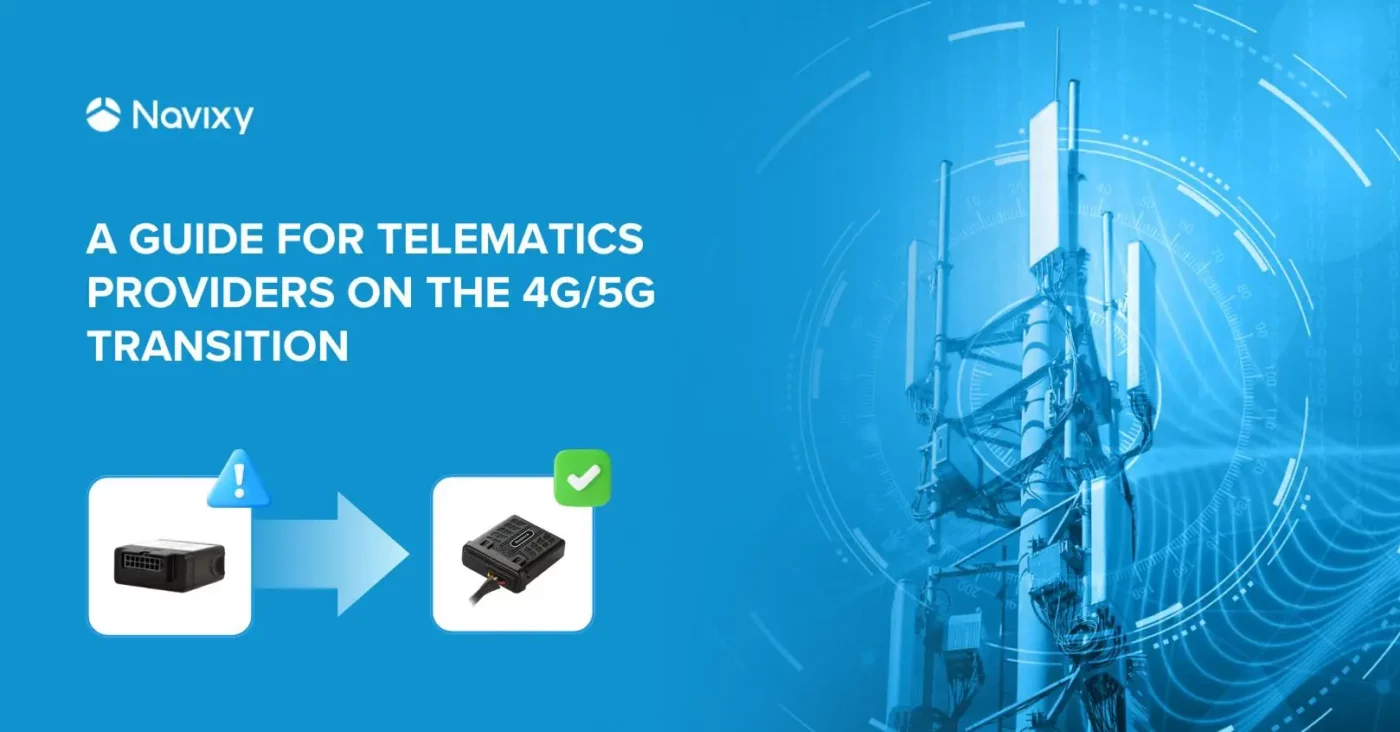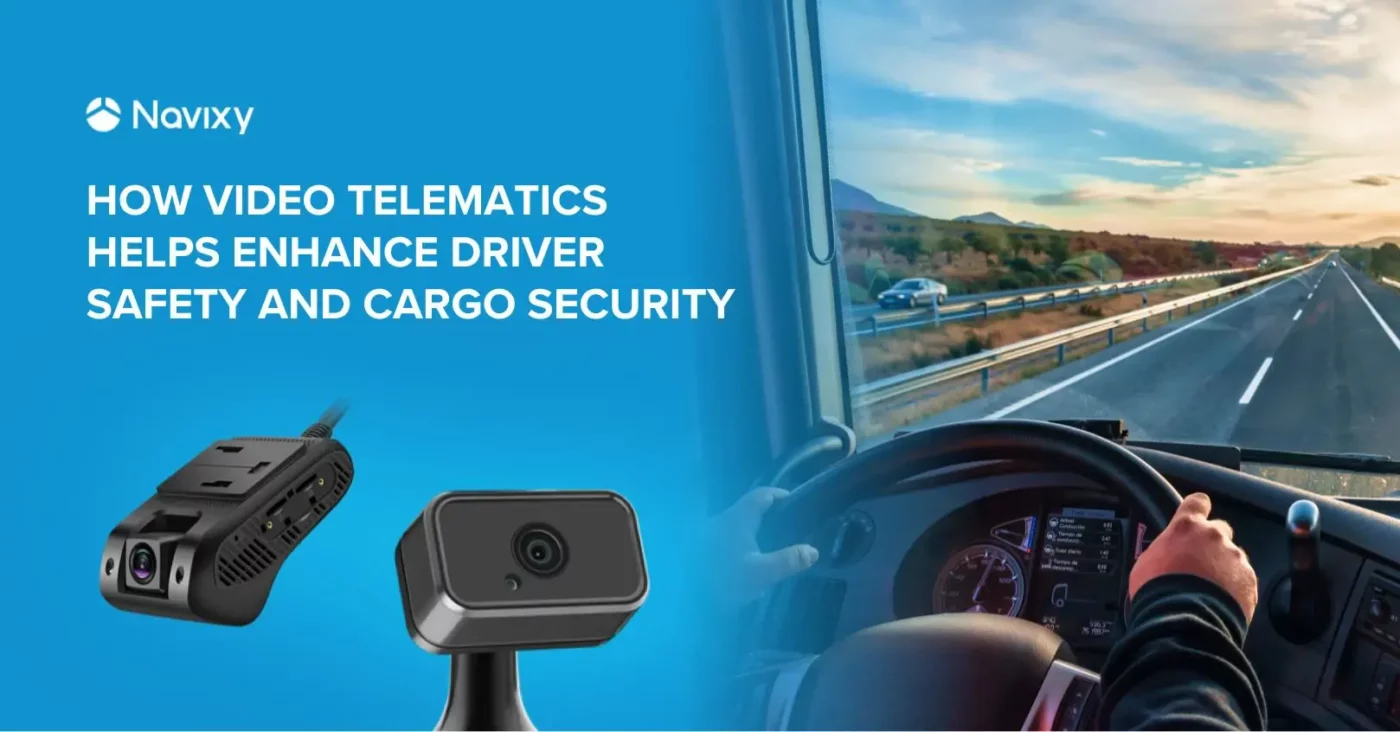Route optimization is highly valuable for fleet owners, since it provides an opportunity for companies to plan, create and analyze most profitable and optimal route strategy for their fleets. Route Optimization option assists companies with various fleet quantities and sizes to efficiently target a wide range of issues they have to deal with during distribution and route planning.
Being an innovative and open-minded company, Navixy implements latest trends in Web and Mobile app development to bring great user experience. Our Smart Route Optimization allows to quickly schedule customer visits and instantly optimize a route. In this post we will describe why Route Optimization is important, how it could be done, and discuss some examples.
An ever-growing market of route optimization
According to Fortune Business insights, the global fleet management software market valued in 2018 at $14,046.7 million, is projected to reach $46,584.7 million by the end of 2026, at a CAGR of 16.52%. One of the important features of modern fleet management platforms is a possibility of route optimization.
Markets and Markets estimate the route optimization software market, valued at $2.50 billion in 2017, to reach $5.07 billion by 2023, at a CAGR of 11.4%. Route optimization software is useful in the fleet management systems, located at the user’s end. It often includes GPS tracking capability and advanced reporting features, providing fleet owners with the fuel-efficient route planning, reducing or preventing unplanned stops and helps to set up a reliable and cost-efficient delivery network.
Route optimization: how it works?
Many years ago actual salesmen had to travel from one dock to another, delivering goods and stuff, and they had to visit a number of cities in one go (well, sailing). For sure they had to thoroughly plan their travel and obviously the shorter the estimated route was, the better. Though it might seem easy on the surface, this problem known as the Travelling Salesman Problem (TSP) is exponentially difficult with gradually increased amount of dots, or cities, the salesman had to visit.
TSP can be visualised using a graph, which is an abstract object containing a set of dots or circles for the vertices, joined by lines or curves for the edges, where the edges represent direct travel between the locations, represented by the dots. Each edge of a graph has a numerical value, associated with it, called a weight. So the task is to find the path with the shortest sum of weights. Weight of an edge also often called as the "cost" of the edge. Therefore, in TSP travelling salesman actually aimed at finding the route with minimum cost.
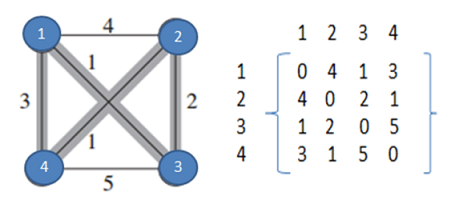
An example of the complete directed graph and relevant cost matrix that includes distances between each points (docks, cities, etc.) is shown on a left figure above. Zeros in cost matrix mean that 2→3 and 3→2 distances are the same. If we go through all the possible case calculations here, then we will find out that the optimal path in this case is 1→3→2→4→1, and the minimum cost would be 7.
Now the question is – how is it all related to the real life? Fair enough. In a real life TSP could be re-formulated and described as follows: suppose your clients have a set of customers and fleet vehicles for deliveries. In this case we need to find a set of routes serving all customers at minimum cost. Here we’re facing so-called Vehicle Routing Problem (VRP), that was for the first time introduced by G. B. Dantzig et al [6].
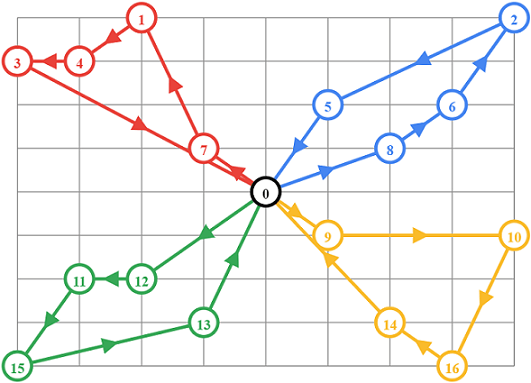
On practical case we have to deal with a decent amount of fleets and need to optimize route for each of them. It is a really challenging task to deal with and there are various smart algorithms, methods and programming paradigms being used and developed to provide some practical solutions.
Besides, in a real-live scenario VRP would naturally include some constraints, such as: time window constraints (a time period during which service should start), time between each pair of customers, duration of each customer visit. In addition, the solution ideally should account for driver breaks, fatigue rules, variable loading/unloading time. One can ask, why not attempt to actually use those constraints to state a relation between variables (service start time intervals, customer visit duration, etc). This is a nice point and the idea behind so-called Constraints Programming (CP).
In a constraint programming paradigm, the relations between variables are stated in the form of constraints. Constraints specify the properties of the solution to be found, rather than a step or step sequence to execute. Therefore, users would just need to state their constraints, and the special solver would try to find solutions, satisfying all the constraints. Constraint programming is a good option for finding VRP solutions, since real-life vehicle routing often has a unique set of constraints and CP model can be modified to include new constraints while preserving core solving method unchanged.
Nowadays, there is a broad range of algorithms collections, vehicle routing libraries and specially developed solvers available to target various optimization problems, including VRP. However, neither solver is able to find the shortest paths for all problems or all the cases. The solution of VRP is essentially a route optimization. Route optimization in this scenario defines a process of finding a most cost-efficient route, that takes into account various relevant factors like, for example, departure/arrival time slots, effective loading and number as well as location of all the stops on the route.
In a real-life cases, route optimization could be potentially performed using following methods:
- hire an expert to do it for you (time/money consuming, not always possible, accuracy issues)
- using various fleet management software (constraints satisfaction problems, not all of it includes efficient route optimization)
- using some of already available "solvers" (not all of them are practical and accurate enough)
- It is also possible to combine these methods with each other and suggest more of them (requires skills, experience, time/money).
In the next chapter we will give some examples and describe our approach to Smart Route Optimization.
Optimization software showcases
To give a few examples, we will consider solutions provided by ABIVIN, Routific, Telogis (Verizon Connect), and also describe our solution - Smart Route Optimization - a New Feature for Effective Planning.
Telogis solutions offer the tools to divide data in a way that makes sense so it’s easier to analyze jobs and relevant details and define optimal territories. It is possible to apply criteria, specific filters and business rules to test-drive scenarios and ultimately form territories. It is possible to model scenarios by location and/or customer needs, load type and size, driver attributes, or predefined criteria to create strategic territories and determine depot locations. This strategy helps to maximize revenue and positioning to plan future resource needs.

Abivin vRoute route optimization software by ABIVIN is an all-in-one route optimization software with state-of-the-art optimization algorithms for optimized route plan and also smart fleet management with real-time delivery updates claiming to be able to help save up to 40% of logistics cost. It allows route optimization using flexible algorithm, with AI/Machine Learning that automatically learns from the historical data of sorting time, service time, or traveling time to predict future actions.

Another example addressing VRP is a solution by Routific. Routific provides a solution to the Vehicle Routing Problem, and takes into account time windows, vehicle capacities, delivery types, priority stops, traffic, driver speeds, driver shift times, driver breaks, and more. It is possible to import customers, customize routes and download routes or send them straight to drivers’ smartphones using mobile application.

Here at Navixy our developers utilize smart algorithms combined with advanced features of constraint programming and multi-purpose meta-heuristic techniques to account for everyday fleet management needs, and addressing VRP in highly efficient and customer-beneficial way. As a result, our new feature called Smart Route Optimization tool has been recently introduced. By simply clicking on the route optimization button, a dispatcher will instantly get the optimal sequence of locations to visit on the map. One click and all the points line up in the most effective route. Our partners and clients can already benefit from it by following optimized routes, faster planning, reducing fuel as well as maintenance costs, making their mobile teams more efficient while reducing overall fleet costs and preserving high service quality.
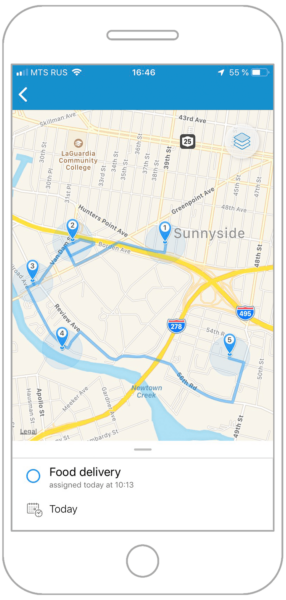
The driver will receive the already optimized route on the smartphone: a list of places to visit in the established sequence, as well as the shortest route from point to point. All the driver has to do is follow the route displayed on the mobile device.
If you would like a bit more about this tool, feel free to visit our portal or contact us directly [email protected].
Smart Route Optimization allows to significantly increase productivity and efficiency of the fleet while reducing costs, however it is a quite difficult option to realize in a precise, efficient and useful way. Nowadays, there is a broad range of algorithms collections, vehicle routing libraries and specially developed solvers available to target VRP and related issues. Here at Navixy our developers utilize smart algorithms combined with advanced features provided by constraint programming to account for everyday fleet management needs and addressing VRP in efficient and customer-beneficial way.
Another practical implementation example of a route optimization is Galileosky device with exclusive Easy Logic technology. We have contacted Dmitry Krasilnikov, a Marketing Manager at Galileosky, and asked him to share with us some relevant information about the solution they have.
Galileosky trackers in smart route optimization
Programmable GPS monitoring devices have found their application in many areas: from cargo transportation to agriculture. Even though their basic function is vehicle tracking, they can perform other functions. For example, you can use trackers for smart route optimization. With the help of programmable Galileosky devices with exclusive Easy Logic technology, you can set notifications about traffic violations and accidents and make a flexible reward and fine system for drivers based on accurate data. And if work hours for heavy vehicles are restricted you can plan routes considering this fact. Let's have a closer look.
Route compliance
Let's assume that the company's fleet moves along a route in which the company spends the optimal amount of fuel and work hours on the road. Compliance with this route can be achieved by geofences.
With the help of tracking devices, you can configure geofences in the specific order. Easy Logic algorithm monitors the order in which the vehicle enters a particular geofence. With the correct sequence, the driver follows the optimal route. If the order is incorrect, for example, you can notify the driver of his mistakes then send a report to the dispatcher.
This allows companies to reduce the cost of fuel and transportation services. This will be especially beneficial when the optimal route is on a quality road.
You also can set geofences depending on the vehicle type to signal that an unsuitable by size or type vehicle has entered an unintended geofence.
Experience based route time
Drivers with different experiences have varying time to pass their routes. The more experienced driver copes with the task faster, whereas the beginners will not have enough time to complete the trip.
To solve this problem, you can set up a system that assigns travel time based on work and driving experience. Driver data is loaded into the RFID tag. When a driver is authorized, the system automatically calculates how much time to give for the driver on a route.
Thus, the company will avoid costs for downtime and delays, as well as efficiently let new drivers gain experience.
Load time control
The extra time taken to load or unload the truck may affect the order. Therefore, the GPS devices can keep track of these periods.
The geofence is configured in the warehouse territory. After that, an Easy Logic algorithm will be able to monitor how much time the driver spends on loading and unloading. If the driver is late, the system will send him a warning by SMS, light or sound signal e.t.c.
Such a system not only allows you to optimize routes, but also shows in which warehouses the most time is spent. This data allows you to restructure and optimize routing.
This is not an extent of the tasks that Galileosky trackers can solve. The speed control depending on weather conditions as well as work and rest hours maintenance also affect route optimization.
Therefore, it is possible to create a custom solution for different areas of business. Everything depends on the complexity and specifications of the projects.
Acknowledgements
We acknowledge all sources of information and help. We especially would like to acknowledge Galileosky, and Dmitry Krasilnikov ( [email protected] ) for sharing with us some information about their product, as well as for collaborative and open-minded approach.
References
- https://www.fortunebusinessinsights.com/industry-reports/fleet-management-software-market-100893
- https://www.marketsandmarkets.com/Market-Reports/route-optimization-software-market-197501388.html?gclid=EAIaIQobChMIlI7MjOno5AIVTuWaCh1-FAnbEAAYASAAEgLTIPD_BwE
- https://www.abivin.com/single-post/2017/08/07/How-To-Effectively-Solve-The-Vehicle-Routing-Problem
- Constraint Programming in a Nutshell by Pierre Flener, Joint ACP and GdR RO Summer School 2017.
- Principles of Constraint Programming by Krzysztof R. Apt, Cambridge University Press 2003.
- The Truck Dispatching Problem, G. B. Dantzig and J. H. Ramser, Management Science, Vol. 6, No. 1 (Oct., 1959), pp. 80-91.
- https://www.verizonconnect.com/telogis
- https://www.abivin.com/vroute
- https://routific.com
- https://www.navixy.com/blog/smart-route-optimization/
- https://galileosky.com
- https://developers.google.com/optimization/routing/vrp
- https://www.altexsoft.com/blog/business/how-to-solve-vehicle-routing-problems-route-optimization-software-and-their-apis
- https://www.thecrazyprogrammer.com/2017/05/travelling-salesman-problem.html
